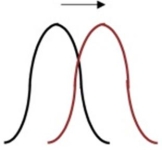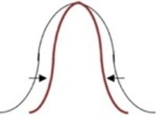During normal climatic conditions, regular amounts of rainfall, the average beak depth for finches was 6.8mm. The Grants found that after a drought, finch beaks increased in depth to 9.8mm. The birds with deep beaks were better able to eat large, hard seeds. Small hard seeds were also available after the drought, but could only be eaten by birds with shallow beaks. What might happen to the population if this trend continues? Choose the graphical representation that would most closely
fit a population that has changed from the majority of individuals having a beak depth of 6.8, to a population where both shallow and deep beaks were the norm and only a few individuals had an average beak depth. What is the name of this type of natural selection?
A) 
directional selection.
B) 
disruptive (diversifying) selection.
C) 
stabilizing selection.
D)  balancing selection.
balancing selection.
Correct Answer:
Verified
Q10: Microevolution would be reflected in disequilibrium in
Q11: Natural selection
A) is evolution.
B) is a key
Q12: A mutation arises in an individual that
Q13: Over generations in a population, individuals with
Q14: Which of the following CANNOT undergo microevolution?
A)
Q16: Directional selection would be expected to occur
Q17: Sexual selection affects male characteristics more than
Q18: Female peahens choose a male peacock for
Q19: Cryptic female choice is a type of
Q20: In humans, sickle-cell anemia is caused by
Unlock this Answer For Free Now!
View this answer and more for free by performing one of the following actions

Scan the QR code to install the App and get 2 free unlocks

Unlock quizzes for free by uploading documents